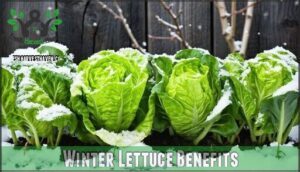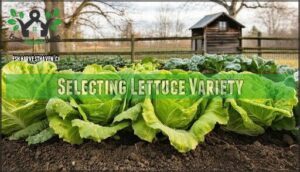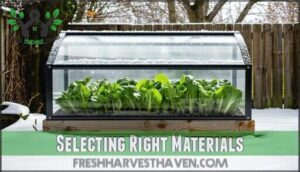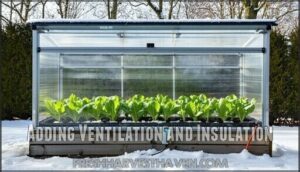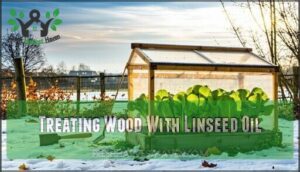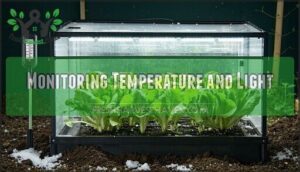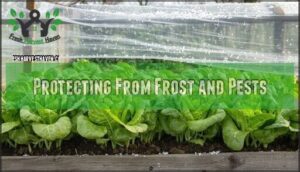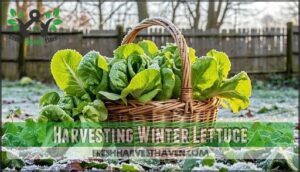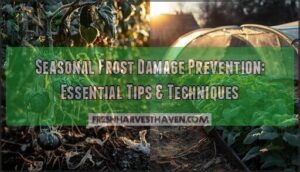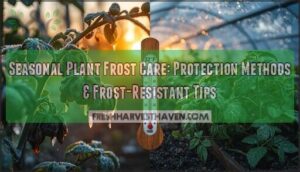This site is supported by our readers. We may earn a commission, at no cost to you, if you purchase through links.
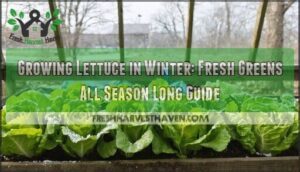
You’ll get sweeter, more tender leaves since cool weather prevents bolting and bitterness.
Choose cold-hardy varieties like ‘Winter Density’ romaine or ‘Arctic King’ butterhead that handle temperatures down to 20°F.
Plant seeds in late summer for fall harvests extending into winter, or use cold frames and row covers for protection.
Winter lettuce needs less water, faces fewer pests, and grows slowly but steadily in shorter daylight.
While growth slows, you’ll enjoy fresh greens when neighbors rely on expensive store-bought options.
The secret lies in timing, variety selection, and understanding how winter’s unique conditions actually work in your favor.
Table Of Contents
- Key Takeaways
- Growing Lettuce Basics
- Winter Lettuce Benefits
- Selecting Lettuce Variety
- Preparing Cold Frame
- Caring for Winter Lettuce
- Harvesting Winter Lettuce
- Frequently Asked Questions (FAQs)
- Can you grow lettuce in the winter?
- Which lettuce grows best in winter?
- What temperature is too cold for lettuce?
- Can you grow lettuce during the winter?
- Can I just scatter lettuce seeds?
- Can I grow lettuce in an unheated greenhouse over winter?
- Can you grow lettuce indoors year round?
- Can you grow lettuce through the winter?
- How cold is too cold for lettuce to grow?
- Can I grow lettuce indoors year round?
- Conclusion
Key Takeaways
- Choose cold-hardy varieties like Winter Density romaine or Arctic King butterhead that’ll survive temperatures down to 20°F and actually taste sweeter in cold weather.
- Time your planting right by direct seeding 10-11 weeks before the first frost or transplanting seedlings 6-7 weeks out for continuous winter harvests.
- Use cold frames or row covers to create protective microclimates that extend your growing season while maintaining ideal temperatures between 45-65°F.
- Harvest in the morning when leaves are crisp and at peak flavor, then store them properly at 32-35°F to maximize shelf life and enjoy fresh greens all winter long.
Growing Lettuce Basics
You’ll master winter lettuce growing by selecting cold-hardy varieties and timing your planting correctly.
The key is choosing the right lettuce type, planting at the ideal time, and providing proper soil conditions with adequate moisture and light.
Choosing Lettuce Variety
When choosing winter lettuce varieties, you’ll want to focus on cold tolerance and disease resistance to guarantee your greens survive harsh conditions.
The best lettuce winter varieties combine fast growth with exceptional frost tolerance, making them perfect for cold-hardy lettuce production.
Consider these essential factors for seed selection:
- Frost tolerance – varieties like Winter Density and Arctic King withstand temperatures down to 20°F
- Disease resistance – Salanova types resist downy mildew in damp winter conditions
- Growth speed – fast-maturing varieties like Black Seeded Simpson beat harsh weather
- Flavor enhancement – cold-tolerant varieties like Rouge d’Hiver develop sweeter taste in winter
Your variety comparison should prioritize lettuce types that thrive in your specific climate zone for consistent winter harvests.
For ideal results, research winter lettuce guides to inform your planting decisions.
Planting Time and Method
Perfect timing transforms your winter lettuce growing from guesswork into guaranteed success. Fall sowing happens 10-11 weeks before your first frost date when direct seeding outdoors, while transplant timing works best at 6-7 weeks out.
Seed starting indoors under grow lights beats late summer heat that triggers dormancy. Winter planting in protected season extenders extends your timeline substantially. Container growing lets you move plants indoors before harsh weather hits.
- Direct seeding works best in cooler soil temperatures below 75°F
- Transplanting seedlings gives you more control over spacing and timing
- Staggered plantings every 2-3 weeks guarantee continuous harvests through winter
- Growing lettuce indoors eliminates weather dependency completely
- Frost-tolerant varieties handle unexpected temperature drops better than tender types
Soil and Temperature Requirements
Once you’ve chosen your timing and method, your lettuce’s success depends on getting the soil and temperature conditions right. Soil pH between 6.0-6.5 creates the foundation your plants need to absorb nutrients efficiently. Well-drained soil prevents root rot during winter’s wet months, while organic matter helps retain soil moisture without waterlogging.
Temperature control makes or breaks your winter harvest. Most lettuce varieties handle their ideal temperature range differently, so you’ll need to match protection methods accordingly.
Proper soil preparation techniques are essential for maximum lettuce growth. Cold frames extend your growth cycle of lettuce by creating microclimates that buffer temperature swings. Frost protection becomes non-negotiable when temperatures drop below each variety’s threshold, protecting your investment through winter’s harshest days.
Moisture and Lighting Needs
Getting your soil temperature right means nothing if you mess up watering and lighting. Your lettuce craves consistent soil moisture without sitting in soggy conditions that invite root rot. Check moisture levels by pressing your finger one inch into the soil – if it’s dry, your plants need water.
Winter’s shorter days create lighting challenges that can stunt growth. You’ll need to supplement natural light sources with artificial options to maintain proper light intensity.
Here’s your essential lighting setup:
- Position full-spectrum LED grow lights 4-6 inches above plants for ideal light intensity
- Run lights 12-16 hours daily to replace missing winter sunlight
- Monitor humidity levels between 50-60% through controlled watering schedules
- Install proper drainage in containers to prevent waterlogged roots
Smart irrigation systems can automate your water requirements, but manual checking guarantees you catch problems early. This balance keeps your winter lettuce thriving when outdoor gardens go dormant.
Winter Lettuce Benefits
Growing lettuce in winter transforms your cold-weather gardening from a dormant period into a productive harvest season.
You’ll enjoy fresh, crisp salads when store-bought greens are expensive and less nutritious, while reducing your grocery bills and increasing your food independence.
Fresh Produce Availability
While grocery stores stock wilted greens shipped from distant farms, your cold frame delivers crisp winter harvest picked minutes before dinner.
This garden-to-table approach guarantees fresh greens maintain peak nutrition and flavor.
Winter harvest lettuce provides reliable year round availability when weather disrupts supply chains, supporting seasonal produce independence from expensive imports and connecting you directly to cold storage alternatives from your backyard.
Increased Self-Sufficiency
Winter lettuce growing transforms your homestead planning into a year-round food security strategy.
You’ll master sustainable living practices that keep your kitchen stocked with fresh greens regardless of weather conditions.
Here’s how winter gardening builds true independence:
- Reduced grocery dependency during expensive winter months when store prices peak
- Season extension techniques that maximize your growing space and harvest windows
- Cold-hardy lettuce varieties that thrive in your indoor winter garden setup
- Year-round growing skills that create reliable food sources through any season
- Winter harvesting knowledge that transforms you into a confident, self-sufficient gardener
Higher Nutritional Value
Winter lettuce packs 30% more vitamin C and double the antioxidants of summer varieties—cold stress creates nutritional powerhouses in your garden.
Beyond cost savings and convenience, your winter lettuce delivers superior nutrient content that transforms ordinary salads into nutritional powerhouses.
Cold temperatures naturally concentrate vitamins and minerals, creating mineral rich greens with enhanced health benefits.
Winter’s chill transforms lettuce into nutrient-dense powerhouses packed with concentrated vitamins and minerals.
Coldhardy lettuce varieties develop higher antioxidant properties during winter months, particularly flavonoids that protect your cells from damage.
The slower growth cycle allows heirloom lettuce to accumulate more omega3 fatty acids and complex compounds.
| Winter Advantage | Summer Lettuce | Winter Lettuce |
|---|---|---|
| Vitamin C Content | Standard levels | 30% higher concentration |
| Antioxidant Levels | Baseline amounts | 2x more flavonoids |
| Mineral Density | Regular absorption | Enhanced calcium/iron |
| Flavor Intensity | Mild taste | Complex, concentrated |
Crisphead lettuce grown in cold frames shows remarkable vitamin boost compared to store-bought options.
Your winter salads become medicinal meals, delivering nutrients that summer growing simply can’t match.
Fresh-picked winter greens retain peak nutrition levels that deteriorate in transported produce.
Reduced Pest Pressure
Mother Nature offers one of winter gardening’s biggest advantages through pest control.
Cold temperatures naturally eliminate aphids, slugs, and other troublesome insects that plague summer gardens.
You’ll find winter pests substantially reduced since freezing weather kills pest eggs and larvae while forcing beneficial predators into dormancy.
This natural pest management makes crop protection much simpler than warm-season growing.
Organic methods become more effective during winter because:
- Fungus and diseases develop slower in cold, dry conditions
- Insect reproduction cycles halt completely below freezing temperatures
- Natural predator-prey balance shifts in your favor without summer heat stress
Your lettuce grows with minimal pest interference, creating healthier plants and reduced need for interventions.
Effective winter garden pest control is vital for a successful harvest.
Selecting Lettuce Variety
You’ll want to choose lettuce varieties that can handle cold temperatures and shorter daylight hours.
The best winter varieties include cold-hardy romaine types like Winter Density, butterhead varieties such as Arctic King, and looseleaf options like Black-Seeded Simpson that keep producing even when temperatures drop.
Romaine Lettuces for Winter
Winter romaine varieties like Winter Density and Rouge d’Hiver deliver crisp, sweet heads that actually improve in cold weather.
Romaine lettuce thrives in winter conditions when you choose the right varieties and provide proper frost protection.
Winter lettuce transforms cold months into harvest season with proper variety selection and frost protection.
These cold-tolerant champions can handle temperatures down to 20°F with adequate winter care, delivering crisp harvests throughout the coldest months. To guarantee a healthy crop, consider implementing effective frost protection methods to shield your plants from damage.
Top Winter Romaine Varieties for Cold Weather Growing:
- Winter Density – Hardy hybrid producing compact, sweet heads that survive repeated freezing
- Rouge d’Hiver – Heirloom variety with stunning red-tinged leaves and exceptional cold tolerance
- Winter Wonderland – Large-headed variety reaching 18 inches tall, perfect for extended harvest timing
- Green Towers – Maintains excellent crunch and flavor even after frost exposure
Butterhead Lettuces for Winter
Butterhead Varieties like ‘Winter Marvel’ and ‘Arctic King’ deliver sweet, tender leaves that outperform summer types in cold weather.
These frost-tolerant varieties survive temperatures down to 20°F with proper frost protection in cold frames.
You’ll appreciate their compact growth habit and superior lettuce nutrition during winter months.
Growing lettuce in winter becomes easier when you choose varieties like ‘Brune d’Hiver’ for reliable harvests.
Winter gardening tips suggest planting ‘Salanova Red Butter’ to add vibrant color to your winter salads.
Winter care focuses on maintaining consistent moisture and adequate ventilation in protected environments.
Lollo Lettuces for Winter
While butterhead varieties offer tender hearts, Lollo lettuces bring winter hardiness with stunning visual appeal that’ll make your cold-season garden the envy of neighbors.
These ruffled beauties represent some of the most frost-tolerant varieties you’ll find, perfect for growing lettuce in winter conditions. Lollo varieties excel in cold tolerance, making winter care surprisingly manageable even for beginners.
Here’s what makes these lettuce varieties winter champions:
- Dark Red Lollo Rossa – Deep burgundy leaves that intensify in cold weather
- Lollo Bionda – Green variety with excellent seed selection for consistent harvests
- Continuous harvest potential – Cut-and-come-again nature extends your winter lettuce supply
- Cold frame lettuce perfection – Thrives in protected structures with minimal heating
Smart harvest tips include picking outer leaves regularly while protecting the growing center for sustained production throughout winter months.
Looseleaf Lettuces for Winter
Looseleaf lettuce varieties stand out as your winter gardening champions, delivering exceptional cold tolerance and continuous harvest potential through the season.
These cut-and-come-again superstars thrive in cold frames while providing vibrant colors for diverse winter salad mixes.
- Black Seeded Simpson offers tender, lime-green leaves with mild flavor that’s perfect for beginners starting their winter lettuce journey
- Red Sails produces stunning burgundy-tinted foliage that adds visual appeal and nutritional variety to cold-weather harvests
- Red Tinged Winter develops attractive green leaves with bronze-red edges for elegant presentation in your winter salads
- Grand Rapids TBR excels in cool, damp conditions when other lettuce varieties struggle to maintain quality growth
Salanova Lettuces for Winter
Salanova lettuce varieties offer triple the yield of standard types, making them perfect for maximizing your winter lettuce harvest.
These frost tolerant varieties like ‘Green Butter’ and ‘Red Oakleaf’ resist downy mildew while maintaining excellent lettuce nutrition in cold conditions.
Their unique one-cut harvest system simplifies picking, and they store twice as long as baby greens.
When growing lettuce in winter, protect your Salanova varieties with cold frame tips like row covers during temperature drops.
Seed starting indoors guarantees healthy transplants for your winter care routine.
Preparing Cold Frame
A cold frame acts as your winter lettuce’s protective shield, creating a mini-greenhouse effect that extends your growing season by several weeks.
You’ll need to build a sturdy structure using the right materials, add proper ventilation to prevent overheating, and treat any wood components to withstand harsh winter conditions, making it a crucial part of the process to ensure a successful growing season.
Building Cold Frame
Now that you’ve chosen your winter lettuce varieties, building your cold frame becomes your next step. This simple structure acts like a mini-greenhouse, capturing solar energy while protecting your greens from harsh winter conditions.
Start by selecting a south-facing location with maximum sunlight exposure. Your cold frame needs:
- Four angled walls that slope toward the front
- A transparent hinged top for easy access
- Bottomless design for direct soil contact
- Sturdy construction to handle snow loads
- Proper drainage to prevent waterlogging
This cold frame box transforms your winter gardening experience, creating the perfect microclimate for frost-tolerant varieties to thrive throughout the coldest months. Using cold frame kits can simplify the construction process and guarantee a well-designed cold frame.
Selecting Right Materials
Your cold frame’s durability depends on smart material choices that withstand winter’s harsh conditions. Cedar lumber resists rot naturally, while twin-wall polycarbonate outperforms glass with superior insulation.
Cold Frame Kits simplify construction, but custom builds offer flexibility. When building a cold frame, considering the type of cedar lumber products is vital for its structural integrity.
Frame Materials for winter success:
- Cedar or pressure-treated lumber – Natural weather resistance prevents decay
- Twin-wall polycarbonate panels – Better insulation than single-pane greenhouse plastic
- Heavy-duty hinges – Smooth operation despite temperature fluctuations
- Weather stripping – Seals gaps for maximum heat retention
Adding Ventilation and Insulation
After selecting materials for your cold frame, proper ventilation systems and insulation materials become your next priority.
Smart climate control prevents overheating and frost damage while maintaining ideal growing conditions.
- Install automatic vent openers that trigger at 70°F to prevent overheating
- Line interior walls with bubble wrap insulation for superior heat retention
- Add adjustable side vents for cross-ventilation during mild winter days
- Position thermometers at plant level to monitor temperature fluctuations accurately
- Create drainage channels to prevent condensation buildup on greenhouse surfaces
Cold frames and polytunnels require balanced airflow – too little ventilation causes disease, while excessive exposure kills tender lettuce.
Your winter protection system should regulate itself automatically, giving plants consistent growing conditions without constant monitoring, using automatic vent openers and ensuring superior heat retention.
Treating Wood With Linseed Oil
After setting up ventilation, you’ll need to protect your cold frame wood with boiled linseed oil for lasting Wood Protection.
This Timber Treatment keeps your winter gardening structure strong through harsh cold weather crops seasons. Boiled linseed oil works better than raw versions because it dries faster—usually within 24-72 hours between coats.
For cedar wood frames, apply thin, even coats using a brush or cloth, working with the grain. Linseed Benefits include deep penetration and moisture resistance.
Always work in ventilated areas and dispose of oil-soaked rags properly to prevent fire hazards. This Wood Finishing step guarantees your garden maintenance investment lasts for years of successful Oil Applications.
When selecting a product, consider the benefits of using high-quality linseed oil products to achieve superior results.
Caring for Winter Lettuce
Once your winter lettuce is planted and protected, proper care becomes essential for healthy growth throughout the cold months.
You’ll need to balance watering, temperature control, and protection to guarantee your greens thrive from December through March, which is crucial for their growth.
Watering and Ventilation
Water Management becomes your winter lettuce lifeline when you balance moisture and airflow.
Check soil moisture weekly—water only when the top inch feels dry to avoid root rot.
Your Ventilation Systems need daily attention: open vents on sunny days to prevent humidity buildup and guarantee proper Air Circulation.
Watch for yellowing leaves, which signal overwatering.
Humidity Control prevents fungal diseases while maintaining ideal growing conditions.
Remember, winter lettuce drinks less than summer crops, so adjust your water needs accordingly.
Proper ventilation keeps your greens healthy and productive throughout the cold months.
Monitoring Temperature and Light
Temperature control plays a vital role in successful winter lettuce growing. You’ll need to monitor both air and soil temperatures while maintaining adequate light exposure throughout the shorter days.
Your cold frame should maintain an ideal temperature between 45-65°F for peak growth. Open vents when air temperatures exceed 70°F to prevent overheating. During extended cloudy periods, supplement natural light with full-spectrum LED grow lights positioned 4-6 inches above plants for 10-12 hours daily.
- Temperature control keeps your lettuce from bolting or freezing
- Light requirements ensure steady growth during dark winter months
- Frost protection saves weeks of growing effort from overnight damage
- Winter lighting transforms disappointing harvests into abundant greens
- Cold frame management creates your personal microclimate oasis
Use a simple thermometer to track daily temperature fluctuations and adjust ventilation accordingly.
Fertilization and Pruning
Winter lettuce thrives with proper nutrient management and strategic pruning techniques. Apply nitrogen-rich fertilizers like fish emulsion every 3-4 weeks, maintaining soil pH between 6.0-6.5 for ideal uptake.
Monitor for pale leaves indicating deficiency. Use crop thinning to remove overcrowded seedlings during transplanting. Soil conditioning with compost supports steady growth.
Cut outer leaves regularly to prevent foliar diseases and improve air circulation. Drip irrigation delivers consistent moisture without leaf-wetting.
This approach maintains productive plants throughout winter’s challenging conditions.
Protecting From Frost and Pests
Your lettuce needs protection from both frost and hungry pests.
Cold frames and row covers create barriers against temperature drops while frost-tolerant varieties handle cold better. Polyethylene sheeting adds extra frost protection when temperatures plummet.
Check plants weekly for aphids and slugs—catching them early prevents damage. Crop barriers keep larger pests away from your greens while maintaining proper airflow around plants.
Understanding frost formation basics is essential for effective winter lettuce care.
Harvesting Winter Lettuce
You’ll know your winter lettuce is ready when the leaves reach full size and feel crisp to the touch, typically 60-90 days after planting depending on variety.
Harvest in the morning when temperatures are coolest to capture peak flavor and guarantee your greens stay fresh longer in storage.
Timing for Optimal Flavor
Perfect harvest timing separates amateur gardeners from those who grow lettuce year round with exceptional flavor profiles.
Your winter lettuce reaches peak taste when you understand how seasonal variations affect development. Most frost-tolerant varieties need 60-80 days from planting schedules to harvest timing, but don’t rely on calendar dates alone.
Instead, watch for these visual cues that signal optimal flavor:
- Leaves feel crisp and snap cleanly when you bend them gently
- Color deepens to rich, vibrant hues showing full nutrient development
- Heads feel firm and dense without any soft or yellowing spots
- Morning dew beads perfectly on healthy, mature leaf surfaces
Morning harvests capture maximum sweetness before afternoon temperatures stress the plants.
Protecting lettuce winter means monitoring frost dates closely—harvest before hard freezes damage tender leaves and compromise taste.
Understanding the essential harvest time is vital for achieving the best flavor and texture in your winter lettuce.
Methods for Harvesting and Storage
Now that you’ve mastered harvest timing, let’s explore proper crop handling techniques.
Use clean scissors for the cut-and-come-again method, snipping outer leaves first. For winter harvest, wash gently and pat dry thoroughly before storing your frost-tolerant varieties.
Storage Duration
These cold storage methods at 32-40°F maximize fresh keeping while minimizing waste from your winter gardening techniques.
Extending Shelf Life
After harvesting your cold-hardy varieties, proper storage tips maximize your winter harvest’s shelf life.
Your fresh keeping success depends on smart handling techniques that preserve those crisp leaves.
Never wash lettuce before storing—moisture accelerates spoilage.
Instead, follow these food safety practices:
- Wrap whole heads in aluminum foil – Creates better moisture barrier than plastic
- Line containers with paper towels – Absorbs excess water that causes wilting
- Store at 32-35°F in crisper drawer – Maintains ideal humidity for extending growing season benefits
- Keep heads intact until serving – Cutting exposes surfaces to faster deterioration
Your frost-tolerant varieties stay fresh for weeks when stored properly, giving you maximum return from your cold weather lettuce investment.
Troubleshooting Common Issues
Even careful gardeners face winter lettuce challenges, but most problems have straightforward fixes.
Frost Damage shows as blackened, wilted leaves—protect plants with row covers or move containers indoors when temperatures drop unexpectedly.
Root Rot develops from overwatering in cold soil—reduce watering frequency and improve drainage around plants.
Leggy Growth happens from insufficient light—supplement with grow lights or relocate plants to brighter spots.
Nutrient Deficiency appears as yellowing leaves—apply diluted liquid fertilizer monthly during active growth periods.
Mold thrives in humid, poorly ventilated spaces—increase air circulation and avoid overhead watering.
Transplant Shock stunts newly moved seedlings—harden off plants gradually before relocating them outdoors.
Choose frost-tolerant varieties and maintain proper spacing to prevent most pests and diseases naturally.
Frequently Asked Questions (FAQs)
Can you grow lettuce in the winter?
Despite winter’s reputation for ending gardening seasons, you can absolutely grow lettuce year-round.
Cold-hardy varieties like Winter Density thrive in temperatures down to 20°F using simple protection like cold frames or row covers.
Which lettuce grows best in winter?
Winter Density romaine and Arctic King butterhead varieties thrive in cold conditions, tolerating temperatures down to 20°F. You’ll get the best results with these hardy, frost-resistant options.
What temperature is too cold for lettuce?
What’s the breaking point for your lettuce crop?
Lettuce can tolerate temperatures down to 40°F, but anything below 20°F will damage or kill most varieties, even cold-hardy ones like Arctic King.
Can you grow lettuce during the winter?
You can absolutely grow lettuce during winter with proper protection.
Cold frames, greenhouses, or row covers help lettuce survive temperatures down to 20°F.
Choose cold-tolerant varieties like Winter Density or Arctic King for best results.
Can I just scatter lettuce seeds?
Like tossing confetti at a party, you can scatter lettuce seeds, but precise planting yields better results.
Space seeds properly, cover lightly with soil, and maintain consistent moisture for ideal germination and growth.
Can I grow lettuce in an unheated greenhouse over winter?
Yes, you can grow lettuce in an unheated greenhouse over winter.
The greenhouse provides essential protection from frost and wind while maintaining slightly warmer temperatures than outdoors, creating ideal conditions for cold-hardy varieties.
Can you grow lettuce indoors year round?
You’re in for a treat! You can absolutely grow lettuce indoors year-round with proper lighting, containers, and temperature control.
Provide 12-16 hours of daily light and maintain consistent moisture for success.
Can you grow lettuce through the winter?
You can definitely grow lettuce through winter using cold frames, greenhouses, or indoor setups.
Choose cold-tolerant varieties like Winter Density or Arctic King, and you’ll enjoy fresh salads all season long.
How cold is too cold for lettuce to grow?
Most lettuce varieties can’t survive temperatures below 22°F (-5°C), but hardy varieties like Arctic King and Winter Density tolerate down to 20°F (-6°C) with proper protection.
Can I grow lettuce indoors year round?
Indoor lettuce thrives year-round with proper light, temperature, and care. You’ll need 12-16 hours of artificial light daily, temperatures between 60-70°F, and consistent moisture for continuous harvests.
Conclusion
Like a steady lighthouse beam cutting through winter darkness, growing lettuce in winter provides reliable fresh greens when gardens seem barren.
You’ve discovered that cold weather actually creates sweeter, more tender leaves while reducing pest problems.
With proper variety selection, cold frames, and timing, you’ll harvest crisp lettuce throughout winter months.
The slower growth means less maintenance but consistent yields. Growing lettuce in winter transforms your garden from seasonal to year-round productivity, delivering fresh nutrition when it’s most needed.

